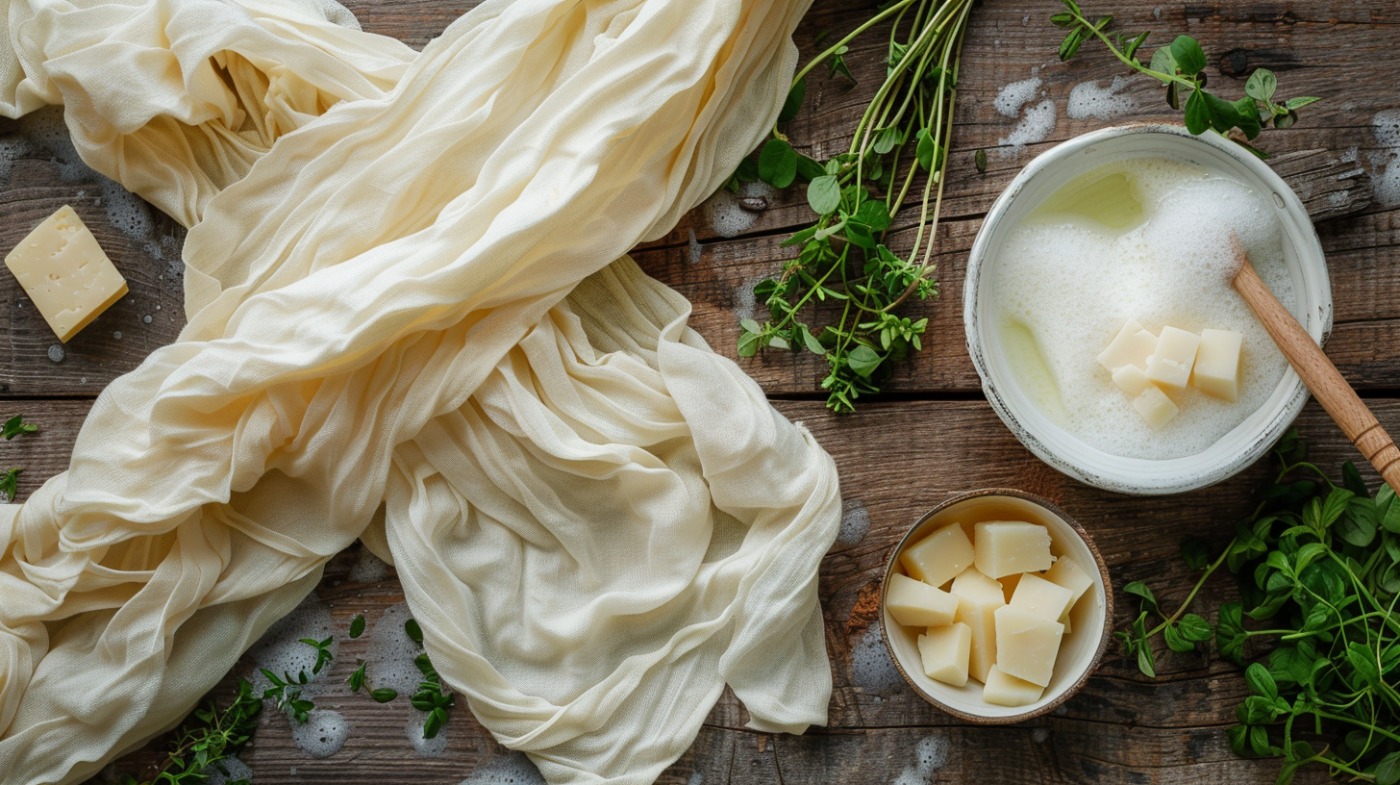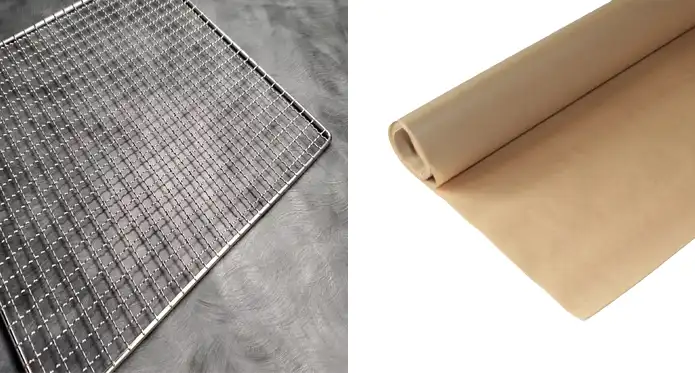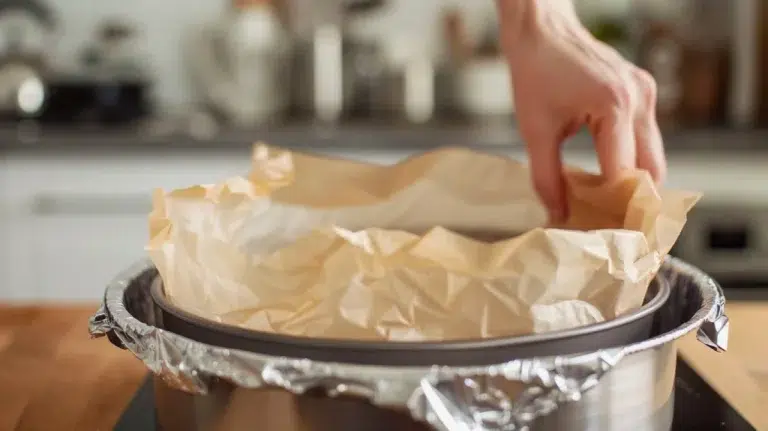How to Clean Cheesecloth: Pro Tips for Spotless Results
To clean your cheesecloth, rinse it immediately under warm running water to remove food particles. You can machine wash it on a delicate cycle with cold water and mild detergent, using a mesh bag to prevent snagging.
Alternatively, soak it in warm water with detergent for 30-60 minutes and gently agitate it before rinsing thoroughly. Always air-dry your cheesecloth to maintain its shape and avoid heat damage.
To prevent mold, make sure it’s completely dry before storing. Would you like more tips and techniques to keep your kitchen essentials in top shape?
Key Takeaways
- Rinse cheesecloth immediately under warm water after use to remove food particles and prevent stains.
- Wash in a washing machine on a delicate cycle with cold water and mild detergent, using a mesh bag.
- For hand washing, soak in warm water with mild detergent for 30-60 minutes, then rinse thoroughly.
- Avoid bleach and fabric softeners; use white vinegar or baking soda for stubborn stains instead.
- Air dry cheesecloth completely to prevent mold growth and maintain fiber integrity; avoid direct sunlight.
Quick and Effective Methods for Cleaning Cheesecloth
To keep your cheesecloth in top condition, below are quick and effective cleaning methods you can follow:
Machine Washing Techniques
When giving your cheesecloth a thorough clean, machine washing can be a convenient option. To guarantee your cheesecloth remains reusable and in good condition, follow these steps:
- Use a mesh laundry bag to prevent snagging and damage during the wash cycle.
- Set your washing machine to a delicate cycle with cold water and a mild detergent for effective cleaning.
- After the wash cycle, rinse the cheesecloth with cold water to eliminate any remaining detergent residue.
- Avoid fabric softeners, as they can leave residues that may contaminate food.
Once your cheesecloth is washed, you can air dry it or use a low-heat setting in the dryer.
Air drying is preferable since it helps maintain the fibers’ integrity and prevents shrinkage. If you opt for the dryer, be cautious to avoid high heat, which could damage your cheesecloth.
Hand Washing Methods
For those who prefer a more hands-on approach, hand-washing cheesecloth can be an effective way to guarantee it remains in great condition.
Start by rinsing the cheesecloth immediately after use under warm running water. This removes food particles and helps prevent stains from setting.
Next, soak the cheesecloth in a solution of warm water and mild detergent for about 30 minutes to an hour. Gently agitate the cloth to loosen any dirt and grease.
Once your soaking time is up, rinse the cheesecloth thoroughly under cold water to eliminate any remaining detergent and food residues. This step is vital for keeping the fabric clean and fresh.
After rinsing, hang the cheesecloth to air dry completely. It’s best to avoid drying it in direct sunlight, as this can damage the delicate fibers.
If you encounter tough stains, consider soaking the cheesecloth in a mixture of baking soda or vinegar with warm water before rinsing and washing.
Stain Removal Tips
Stains on cheesecloth can be frustrating, but tackling them doesn’t have to be a challenging task. The key to effective stain removal lies in acting quickly and using the right methods. Here are some tips to help you keep your cheesecloth spotless:
- Rinse thoroughly under warm running water immediately after use to prevent stains from setting.
- For stubborn stains, soak the cheesecloth in a warm solution of baking soda or white vinegar for 30 minutes to an hour, then rinse thoroughly.
- For tomato and fruit stains, apply white vinegar and lemon juice directly to the stained area before rinsing with cold water.
- If persistent odors linger, soak the cheesecloth in boiling water for five minutes to sanitize and eliminate smells.
Avoid using bleach, as it can weaken the delicate fibers of cheesecloth. Instead, consider using hydrogen peroxide for safe and effective stain removal while maintaining hygiene.
Drying Cheesecloth Properly
When it comes to drying cheesecloth, air drying is the best method for preserving its delicate fibers and avoiding shrinkage.
If you opt for a dryer, keep the heat low and remove it promptly to prevent any damage.
Air-Drying Techniques
Air-drying cheesecloth is an essential step that guarantees your fabric remains in top condition for future use.
By air-drying properly, you prevent shrinkage and maintain the integrity of the fibers. Here’s how to do it effectively:
- Hang it up: After washing, spread the cheesecloth out over a clean surface like a cabinet or a clothesline. This allows for proper airflow.
- Choose a cool spot: Place it in a well-ventilated area, avoiding direct sunlight, as exposure can lead to discoloration and deterioration.
- Watch for moisture: Ascertain the cheesecloth remains there until it’s thoroughly dry. Any residual moisture can promote mold growth, which you definitely want to avoid.
- Store it right: Once completely dry, fold the cheesecloth neatly and store it in a cool, dry place. This helps maintain its condition for future use.
Machine Drying Tips
If you’re considering machine drying your cheesecloth, it’s crucial to do it right to preserve its delicate fibers.
Start by placing your cheesecloth in a mesh laundry bag before tossing it into the dryer. This simple step helps prevent snagging on other items, guaranteeing your cheesecloth remains intact during the drying process.
Set your dryer to low heat; this gentle wash action will protect the fibers from shrinkage and damage.
As soon as the drying cycle finishes, promptly remove the cheesecloth to avoid over-drying. Leaving it in the dryer too long can weaken the material, reducing its usability for future tasks.
Additionally, steer clear of using fabric softeners or dryer sheets, as these can leave residues that may contaminate your cheesecloth, rendering it ineffective.
After machine drying, regularly check your cheesecloth for any signs of wear or damage. This practice guarantees it stays in top shape, ready for your next culinary adventure.
Avoiding Heat Damage
Maintaining the integrity of your cheesecloth requires careful attention to heat exposure during drying. High heat can lead to serious shrinkage and damage, weakening the delicate fibers over time.
To guarantee your cheesecloth remains usable, consider these drying methods:
- Air-drying is the most gentle option, preventing shrinkage and damage.
- If using a dryer, set it to low heat and remove the cheesecloth promptly after the cycle ends to avoid over-drying.
- Avoid prolonged exposure to direct sunlight, which can cause discoloration and degrade the fabric.
- Regular checks should be performed for any signs of damage after drying; heat can cause unseen wear that affects future usability.
Storing Cheesecloth Safely
To keep your cheesecloth in top shape, guarantee it’s completely clean and dry before tucking it away.
Once your cheesecloth is fresh and dry, fold it neatly and store it for future use in a cool, dry place like a kitchen cupboard or drawer. This helps maintain its shape and usability for your next cooking adventure.
For added protection, consider placing the folded cheesecloth inside a plastic bag or an airtight container. This additional layer keeps dust and contaminants at bay, ensuring your cheesecloth remains clean and ready for action.
It’s also wise to clearly label or separate your stored cheesecloth from cleaning materials to avoid any mix-ups or potential contamination.
If you find your cheesecloth worn out from frequent use, don’t toss it just yet! You can repurpose it for crafting or as cleaning rags, extending its usability beyond the kitchen.
Common Mistakes to Avoid When Cleaning Cheesecloth
Cleaning cheesecloth might seem straightforward, but there are several common pitfalls that can lead to frustration and diminished quality. To maintain the integrity of your cheesecloth, steer clear of these mistakes:
- Avoid using bleach or harsh chemicals; they can break down the delicate fibers.
- Do not let food residue sit; rinse immediately after use to prevent stains and odors from setting.
- Avoid washing in a dishwasher; the high temperatures can cause damage to the fabric.
- Confirm that the cheesecloth is completely dry before storing it to prevent mold growth.
Additionally, always remember to wash cheesecloth before use to remove any manufacturing residues.
When cleaning, rinse with cold water to maintain its texture and functionality.
Also, avoid using fabric softeners, which can leave residues that contaminate food.
If you encounter stains, treat them promptly to avoid permanent damage.
Frequently Asked Questions
Are You Supposed to Wash Cheesecloth?
Washing cheesecloth is like giving your cooking a golden ticket. You’ll remove impurities and prevent nasty flavor contamination. Soak it in hot water, rinse well, and you’re set for delicious culinary adventures!
How Do You Clean Cheesecloth for Reuse?
To clean cheesecloth for reuse, rinse it immediately after use under warm water. For stubborn stains, soak in a baking soda solution, then machine wash on a delicate cycle. Finally, air dry completely before storing.
How Do You Clean a Straining Cloth?
Rinsing a straining cloth immediately after use is a way to clean it. Soak it in warm water with vinegar for an hour, then rinse thoroughly. Air-dry completely to keep it fresh and prevent mold growth.
How to Get Wax off of Cheesecloth?
Did you know that nearly 50% of kitchen cloths harbor unwanted residues? To remove wax, heat the cloth between absorbent paper, freeze it for easier scraping, or soak in soapy water for effective cleaning.
Take Advantage of Clean Cheesecloth for Big Kitchen Rewards
Cleaning cheesecloth might seem like a chore, but it’s a small step that leads to big results in your kitchen.
Just imagine the next time you whip up a batch of homemade cheese or strain a delicious broth—using fresh, clean cheesecloth makes all the difference.
You can ensure that this versatile kitchen tool is always ready for your next culinary adventure by following the right washing techniques and storing it properly. So, embrace the process and enjoy the rewards.







